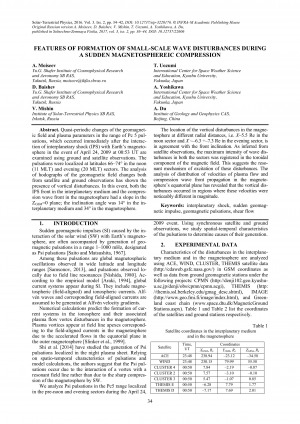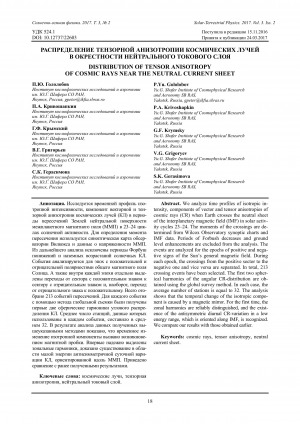Количество страниц: 2 с.
Evolution of ionospheric current systems for the geomagnetic impulse SI/SC by the magnetometer global network data : [тезисы докладов] / S. I. Solovyev, A. V. Moiseyev, M. Engebretson, K. Yumoto // Physics of auroral phenomena : 24 annual seminar, 27 February - 2 March 2001. – 2001. – P. 36.
Количество страниц: 2 с.
- Математика. Естественные науки > Астрономия. Астрофизика. Исследование космического пространства. Геодезия,
- Математика. Естественные науки > Геология. Геологические и геофизические науки,
- НАУКА ЯКУТИИ > МАТЕМАТИКА. ЕСТЕСТВЕННЫЕ НАУКИ > Астрономия. Астрофизика. Исследование космического пространства. Геодезия,
- НАУКА ЯКУТИИ > МАТЕМАТИКА. ЕСТЕСТВЕННЫЕ НАУКИ > Геология. Геологические и геофизические науки.
Solar X-ray Bursts as a Possible Predictor of the Magnetic Storm in November 2004 / V. A. Velichko, D. G. Baishev, I. Ya. Plotnikov, N. G. Skryabin, R. N. Boroev // Solar Extreme Events Fundamental Science and Applied Aspects Nor-Amberd, Armenia 26-30 September 2005 : proceedings of the Second International Symposium / edited by A. Chilingarian and G. Karapetyan. − Erevan : Cosmic Ray Division, Alikhanyan Physics Institute, 2006. − P. 107-108.
Количество страниц: 4 с.
- Математика. Естественные науки > Астрономия. Астрофизика. Исследование космического пространства. Геодезия,
- Математика. Естественные науки > Геология. Геологические и геофизические науки,
- НАУКА ЯКУТИИ > МАТЕМАТИКА. ЕСТЕСТВЕННЫЕ НАУКИ > Астрономия. Астрофизика. Исследование космического пространства. Геодезия,
- НАУКА ЯКУТИИ > МАТЕМАТИКА. ЕСТЕСТВЕННЫЕ НАУКИ > Геология. Геологические и геофизические науки.
Basic Regimes of the Super-Storm on Nov 20, 2003 and the Problems Substorms-Storm / V. M. Mishin, M. Foerster, T. I. Saifudinova, A. D. Bazarzhapov, L. A. Sapronova, V. P. Golovkov, P. Stauning, J. Watermann, and S. I. Solovyev // Solar Extreme Events Fundamental Science and Applied Aspects Nor-Amberd, Armenia 26-30 September 2005 : proceedings of the Second International Symposium / edited by A. Chilingarian and G. Karapetyan. − Erevan : Cosmic Ray Division, Alikhanyan Physics Institute, 2006. − P. 86-89.
Количество страниц: 3 с.
- Математика. Естественные науки > Астрономия. Астрофизика. Исследование космического пространства. Геодезия,
- Математика. Естественные науки > Геология. Геологические и геофизические науки,
- Прикладные науки. Медицина. Ветеринария. Техника. Сельское хозяйство > Инженерное дело. Техника в целом,
- НАУКА ЯКУТИИ > МАТЕМАТИКА. ЕСТЕСТВЕННЫЕ НАУКИ > Астрономия. Астрофизика. Исследование космического пространства. Геодезия,
- НАУКА ЯКУТИИ > ПРИКЛАДНЫЕ НАУКИ. МЕДИЦИНА. ТЕХНИКА. СЕЛЬСКОЕ ХОЗЯЙСТВО > Инженерное дело. Техника в целом,
- НАУКА ЯКУТИИ > МАТЕМАТИКА. ЕСТЕСТВЕННЫЕ НАУКИ > Геология. Геологические и геофизические науки.
Dynamics of the Ionospheric Convection Systems Observed during The Super-Storm on Nov. 20, 2003 / M. Foerster, V. M. Mishin, T. I. Saifudinova, A. D. Bazarzhapov, L. A. Sapronova, V. P. Golovkov, P. Stauning, J. Watermann, and S. I. Solovyev // Solar Extreme Events Fundamental Science and Applied Aspects Nor-Amberd, Armenia 26-30 September 2005 : proceedings of the Second International Symposium / edited by A. Chilingarian and G. Karapetyan. − Erevan : Cosmic Ray Division, Alikhanyan Physics Institute, 2006. − P. 83-85.
Количество страниц: 4 с.
Skryabin, N. G. Influence of Jupiter on cosmic ray intensity variations / N. G. Skryabin, S. N. Samsonov, I. Ya. Plotnikov // Physics of auroral phenomena : proceedings of the 25th annual seminar, Apatity, 26 February – 1 March 2002. – 2002. – P. 137-139.
Количество страниц: 14 с.
Evolution of negative SI-induced ionospheric flows observed by SuperDARN King Salmon HF radar / T. Hori, A. Shinbori, N. Nishitani, T. Kikuchi, S. Fujita, T. Nagatsuma, O. Troshichev, K. Yumoto, A. Moiseyev, and K. Seki // Journal of Geophysical Research: Space Physics. – 1978. – 2012 (December), vol. 117, N 12. – P. A12223.
DOI: 10.1029/2012JA018093
Количество страниц: 9 с.
- Математика. Естественные науки > Астрономия. Астрофизика. Исследование космического пространства. Геодезия,
- Математика. Естественные науки > Геология. Геологические и геофизические науки,
- НАУКА ЯКУТИИ > МАТЕМАТИКА. ЕСТЕСТВЕННЫЕ НАУКИ > Астрономия. Астрофизика. Исследование космического пространства. Геодезия,
- НАУКА ЯКУТИИ > МАТЕМАТИКА. ЕСТЕСТВЕННЫЕ НАУКИ > Геология. Геологические и геофизические науки.
Quasi-periodic changes of the geomagnetic field and plasma parameters in the range of Pc 5 pulsations, which occurred immediately after the interaction of interplanetary shock (IPS) with Earth’s magnetosphere in the event of April 24, 2009 at 00:53 UT are examined using ground and satellite observations. The pulsations were localized at latitudes 66-74° in the noon (11 MLT) and evening (20 MLT) sectors. The analysis of hodographs of the geomagnetic field changes both from satellite and ground observations has shown the presence of vortical disturbances. In this event, both the IPS front in the interplanetary medium and the compression wave front in the magnetosphere had a slope in the ZGSM=0 plane; the inclination angle was 14° in the interplanetary medium and 34° in the magnetosphere. The location of the vortical disturbances in the magnetosphere at different radial distances, i.e. X ~5.5 Re in the noon sector and X ~-6.3 ÷-7.3 Re in the evening sector, is in agreement with the front inclination. As inferred from satellite observations, the maximum intensity of wave disturbances in both the sectors was registered in the toroidal component of the magnetic field. This suggests the resonant mechanism of excitation of these disturbances. The analysis of distribution of velocities of plasma flow and compression wave front propagation in the magnetosphere’s equatorial plane has revealed that the vortical disturbances occurred in regions where these velocities were noticeably different in magnitude.
Features of formation of small-scale wave disturbances during a sudden magnetosphereic compression = Особенности формирования мелкомасштабных волновых возмущений во время резкого сжатия магнитосферы / A. Moiseev, D. Baihsev, V. Mishin, T. Uozumi, A. Yoshikawa, A. Du // Солнечно-земная физика = Solar-Terrestrial Physics. – 2017, т. 3, N 2 : 13-я российско-китайская конференция по космической погоде. – С. 36-44.
DOI: 10.12737/22606
Количество страниц: 9 с.
- Математика. Естественные науки > Астрономия. Астрофизика. Исследование космического пространства. Геодезия,
- Математика. Естественные науки > Геология. Геологические и геофизические науки,
- НАУКА ЯКУТИИ > МАТЕМАТИКА. ЕСТЕСТВЕННЫЕ НАУКИ > Астрономия. Астрофизика. Исследование космического пространства. Геодезия,
- НАУКА ЯКУТИИ > МАТЕМАТИКА. ЕСТЕСТВЕННЫЕ НАУКИ > Геология. Геологические и геофизические науки.
Monitoring and investigating space weather effects with meridional chain of instruments in Yakutia: a brief overview = Мониторинг и исследование эффектов космической погоды с помощью меридиональной цепочки инструментов в Якутии: краткий обзор / D. G. Baihsev, S. N. Samsonov, A. V. Moiseev, R. N. Boroyev, A. E. Stepanov, V. I. Kozlov, A. A. Korsakov, A. A. Toropov, A. Yoshikawa, K. Yumoto // Солнечно-земная физика = Solar-Terrestrial Physics. – 2017, т. 3, N 2 : 13-я российско-китайская конференция по космической погоде. – С. 27-35.
DOI: 10.12737/22607
Количество страниц: 5 с.
The observable anisotropy of cosmic rays has first been decomposed into zonal harmonics and components of vector and tensor anisotropy. We examine Forbush decreases in cosmic rays that occurred in November 2001 and November 2004. It is shown that at the beginning of a Forbush decrease an antisunward convective current of cosmic rays predominates; and during the recovery phase, a sunward diffusive current of particles along the interplanetary magnetic field dominates. During the phase of intensity drop, short-time decreases in the second zonal harmonic take place. These decreases occur with abrupt changes of the interplanetary magnetic field intensity and solar wind speed. During the passage of large-scale solar wind disturbances, the tensor anisotropy behaves in a complicated way. To explain its behavior, a further detailed investigation is required.
Investigating tensor anisotropy of cosmic rays during large-scale solar wind disturbances = Исследование тензорной анизотропии космических лучей во время крупномасштабных возмущений солнечного ветра / P. Yu. Gololobov, P. A. Krivoshapkin, G. F. Krymsky, V. G. Grigoryev, S. K. Gerasimova // Солнечно-земная физика = Solar-Terrestrial Physics. – 2017, т. 3, N 2 : 13-я российско-китайская конференция по космической погоде. – С. 22-26.
DOI: 10.12737/22604
Количество страниц: 4 с.
We analyze time profiles of isotropic intensity, components of vector and tensor anisotropies of cosmic rays (CR) when Earth crosses the neutral sheet of the interplanetary magnetic field (IMF) in solar activity cycles 23-24. The moments of the crossings are determined from Wilcox Observatory synoptic charts and IMF data. Periods of Forbush decreases and ground level enhancements are excluded from the analysis. The events are analyzed for the epochs of positive and negative signs of the Sun’s general magnetic field. During each epoch, the crossings from the positive sector to the negative one and vice versa are separated. In total, 213 crossing events have been selected. The first two spherical harmonics of the angular CR-distribution are obtained using the global survey method. In each case, the average number of stations is equal to 32. The analysis shows that the temporal change of the isotropic component is caused by a magnetic mirror. For the first time, the zonal harmonics are reliably distinguished, and the existence of the antisymmetric diurnal CR-variation in a low energy range, which is oriented along IMF, is recognized. We compare our results with those obtained earlier.
Distribution of tensor anisotropy of cosmic rays near the neutral current sheet = Распределение тензорной анизотропии космических лучей в окрестности токового слоя / P. Yu. Gololobov, P. A. Krivoshapkin, G. F. Krymsky, V.G. Grigoryev, S. K. Gerasimova // Солнечно-земная физика = Solar-Terrestrial Physics. – 2017, т. 3, N 2 : 13-я российско-китайская конференция по космической погоде. – С. 18-21.
DOI: 10.12737/22603









